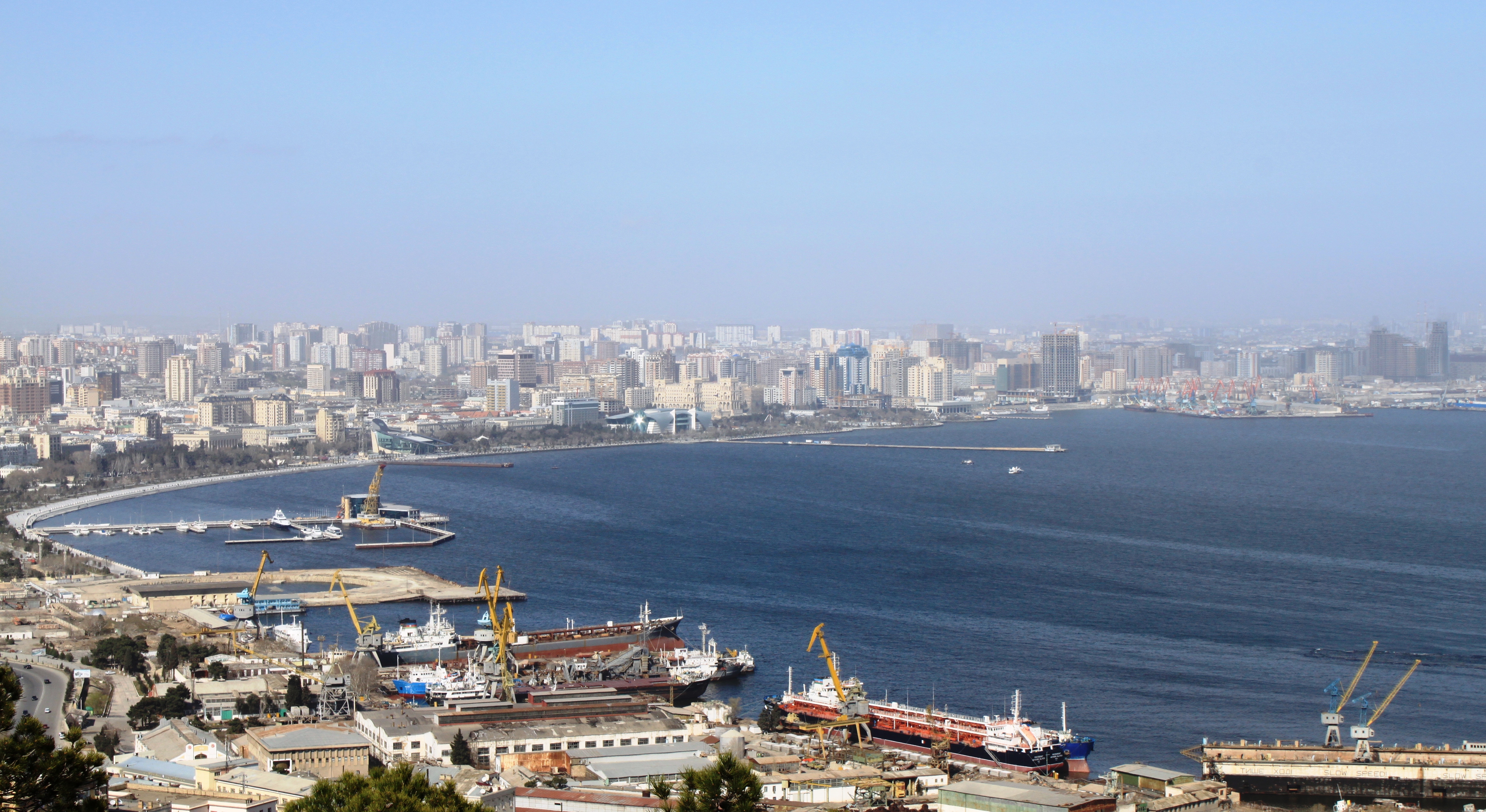By Nargiza Umarova
Azerbaijan is strengthening its political and economic ties with the Taliban government by playing an active role in creating and developing promising transport routes to South Asia. At the forefront is the Lapis Lazuli Corridor, launched in 2018 through a joint initiative of Afghanistan, Azerbaijan, Turkey, Georgia and Turkmenistan, similar to the ancient route of the Great Silk Road. The possibility of extending the corridor to South Asia is being considered, which would have geo-economic and geopolitical implications for Uzbekistan.

Credit: Wikimedia Commons
BACKGROUND: The US$2 billion Lapis Lazuli Agreement was signed by Afghanistan, Azerbaijan, Georgia, Turkey and Turkmenistan on 15 November 2017. The route runs from the Afghan cities of Aqina in Faryab Province and Torghundi in Herat Province, through the Caspian Sea ports of Turkmenbashi and Baku, and the Georgian Black Sea ports of Poti or Batumi, to Istanbul or Kars in Turkey, with further access to the European transport system.
The first test shipment along the Lapis Lazuli logistics chain was carried out in 2018. In January 2021, Turkmenistan, Azerbaijan and Afghanistan signed a trilateral roadmap to develop this route. However, implementation of the document was suspended due to the Taliban's seizure of power in Kabul in August 2021.
Against the backdrop of pragmatic interactions between Central Asian states — particularly Uzbekistan — and the current Afghan leadership, Azerbaijan is also seeking to strengthen its position in Afghanistan as a partner in trade, the economy, transport, and logistics.
Baku’s main priority is the Middle Corridor project, a vital logistics link between China and Europe. The Lapis Lazuli Corridor essentially extends the Middle Corridor to Afghanistan. This enables Kabul to take part in trans-Caspian shipping and to redirect some of its export cargo bound for the European market from Pakistan or Iran, to the South Caucasus and Turkey.
In 2024, Afghanistan’s total trade with the EU was approximately US$ 42 million, which is 15.9 percent higher than the previous year’s figure. Experts predict that this growth trend will continue. Meanwhile, Azerbaijan is attempting to accelerate these processes by adopting a proactive approach to its relations with the Taliban.
On July 2, 2025, on the sidelines of the Economic Cooperation Organization summit in Khankendi, Azerbaijan, Abdul Ghani Baradar, Afghanistan’s Deputy Prime Minister for Economic Affairs, met with Azerbaijani Prime Minister Ali Asadov. They emphasized Baku’s readiness to increase export and import volumes with Afghanistan. The Afghan delegation visited the Baku International Seaport, where they discussed expanding the geography of freight transport along the South Asia-Caucasus-Europe route and integrating Afghanistan into the Middle Corridor.
Azerbaijan and Turkmenistan have made significant efforts to develop the infrastructure of the Lapis Lazuli Corridor. Azerbaijan has invested approximately US$ 1 billion in two vital elements of the project: the Alat Port in Baku and the Baku-Tbilisi-Kars railway. Meanwhile, Turkmenistan constructed the Atamurat (Kerki)-Ymamnazar-Aqina railway in 2016, and connected the Afghan cities of Aqina and Andkhoy by rail in 2021. The Caspian port of Turkmenbashi is also being modernized to increase its capacity. In order to generate economic returns on their investments and reap the long-term benefits of transport service exports, it is crucial for Baku, Ashgabat and other stakeholders along the route to maximize its utilization. This justifies the idea of extending the Lapis Lazuli Corridor to Pakistan and India, which would run contrary to Uzbekistan’s interests.
IMPLICATIONS: It is assumed that the transport corridor from Europe to India via the South Caucasus, Turkmenistan and Afghanistan will become an alternative to Tashkent’s strategic plan for connecting Eastern Europe with the Indian subcontinent. This plan involves linking the Trans-Afghan Railway (Kabul Corridor) with the Northern Railway Corridor through Russia. To this end, Uzbekistan has initiated the formation of the Belarus-Russia-Kazakhstan-Uzbekistan-Afghanistan-Pakistan-Indian Ocean ports transit route, which is set to launch in multimodal format soon.
The main benchmark for calculating the Kabul Corridor’s economic efficiency and feasibility is India’s growing potential for trade with Central Asian countries, the EU, China and Russia.
In the 2024 fiscal year, India’s trade turnover with the EU exceeded US$ 137 billion, with China US$ 118 billion, with Russia US$ 70 billion, and with Central Asian countries US$ 1.7 billion. The majority of Indian goods are delivered to promising markets by sea, which incurs high financial and time costs. The integration of India and Pakistan's transport space into the Eurasian road network is expected to stimulate land transportation along the South Asia-Europe axis. This shift holds great potential for the Kabul Corridor, with a projected annual cargo volume of up to 22 million tons, most of which will be in transit.
However, the extension of the Middle Corridor to Afghanistan and the development of further access to Pakistan and India will redistribute the flow of cargo from South Asian countries to Europe in favor of Turkmenistan and Azerbaijan, who are connected by the Caspian Sea. In turn, this risks diminishing Uzbekistan’s exclusive role as a trans-Eurasian transport link.
In theory, the Lapis Lazuli Corridor could be extended to Pakistan by constructing a railway line from Torghundi station on the Afghan-Turkmen border to Naibabad station, which marks the beginning of the Afghan section of the Kabul Corridor. Although this would exclude Uzbekistan from the India-EU supply chain, it would enable the Kabul Corridor to attract additional cargo from the South Caucasus and Turkmenistan. However, this advantage would not offset Uzbekistan’s loss of transit flows from the larger economic centers of Eurasia.
Connecting the Lapis Lazuli and Kabul corridors would motivate constructing the Herat-Mazar-i-Sharif railway, which would breathe new life into the long-standing Five Nations Railway Corridor project, running through China, Kyrgyzstan, Tajikistan, Afghanistan and Iran. The Five Nations Route bypasses Uzbekistan, significantly reducing the distance between East and West. This will probably diminish the importance of the Southern Railway Corridor, which runs through Central Asia, Iran, and Turkey, as well as the China-Kyrgyzstan-Uzbekistan railway, which is intended to be an important component of this route.
At the same time, constructing the Herat-Mazar-i-Sharif railway could undermine the Lapis Lazuli Corridor’s competitive advantage by increasing Iranian transit. Iran already has rail access to northern Afghanistan via the Khaf-Herat route, which is used to deliver Afghan cargo to Europe. Extending the Khaf-Herat railway to Naibabad station near Mazar-i-Sharif and connecting it to the Kabul Corridor would enable Iran to divert potential cargo traffic from India and Pakistan to Turkey and Europe via itself, thereby depriving Central Asian and South Caucasian countries of transit benefits. Consequently, there is a possibility that the Lapis Lazuli Corridor could be extended to South Asia, bypassing Kabul and instead passing through Kandahar. This would stimulate the development of the western Trans-Afghan Railway along the Torghundi-Herat-Kandahar-Spin Buldak route. Turkmenistan and Kazakhstan promote the project as an alternative to the Kabul Corridor.
Russia should be considered a potential stakeholder in the extension of the Lapis Lazuli Corridor along any of the trans-Afghan routes. Moscow has already announced plans to connect with Afghanistan via the Caspian Sea, utilising Turkmenistan’s port and rail infrastructure, which would integrate Russia into the Lapis Lazuli Corridor. This would establish a connection between India and Russia, and potentially Europe, through Turkmenistan and the Caspian port of Turkmenbashi, rather than through Uzbekistan.
CONCLUSIONS: Uzbekistan’s best option for maintaining and enhancing its competitive advantages in trans-Eurasian and trans-Afghan transport is to accelerate construction of the Kabul Corridor, involving all Central Asian states financially to the maximum extent possible. Kazakhstan’s practical support for developing the Kabul Corridor is important, as connecting it to the Northern Railway Route to Europe will enable Astana to receive an additional transit flow of up to 20 million tons per year. This will preempt any potential competition from Astana and Ashgabat in developing trans-Afghan transport connections.
It would be worth proposing to Baku the joint promotion of a new multimodal corridor from India, Pakistan, Afghanistan, Uzbekistan and Kazakhstan to Azerbaijan, Georgia, and the EU. This would stimulate the development of the Middle Corridor by increasing transport from South Asia and Afghanistan to Europe via the Caspian Sea.
Moreover, an alternative should be developed to the Five Nations Route, instead envisaging a connection between China, Afghanistan and Iran through Uzbekistan and neighboring countries. This would ensure the profitability of the Mazar-i-Sharif-Herat railway project for Tashkent.
AUTHOR'S BIO: Nargiza Umarova is a Senior Research Fellow at the Institute for Advanced International Studies (IAIS), University of World Economy and Diplomacy (UWED) and an analyst at the Non-governmental Research Institution ‘Knowledge Caravan’, Tashkent, Uzbekistan. Her research activities focus on developments in Central Asia, trends in regional integration and the influence of great powers on this process. She also explores Uzbekistan’s current policy on the creation and development of international transport corridors. She can be contacted at This email address is being protected from spambots. You need JavaScript enabled to view it. .



